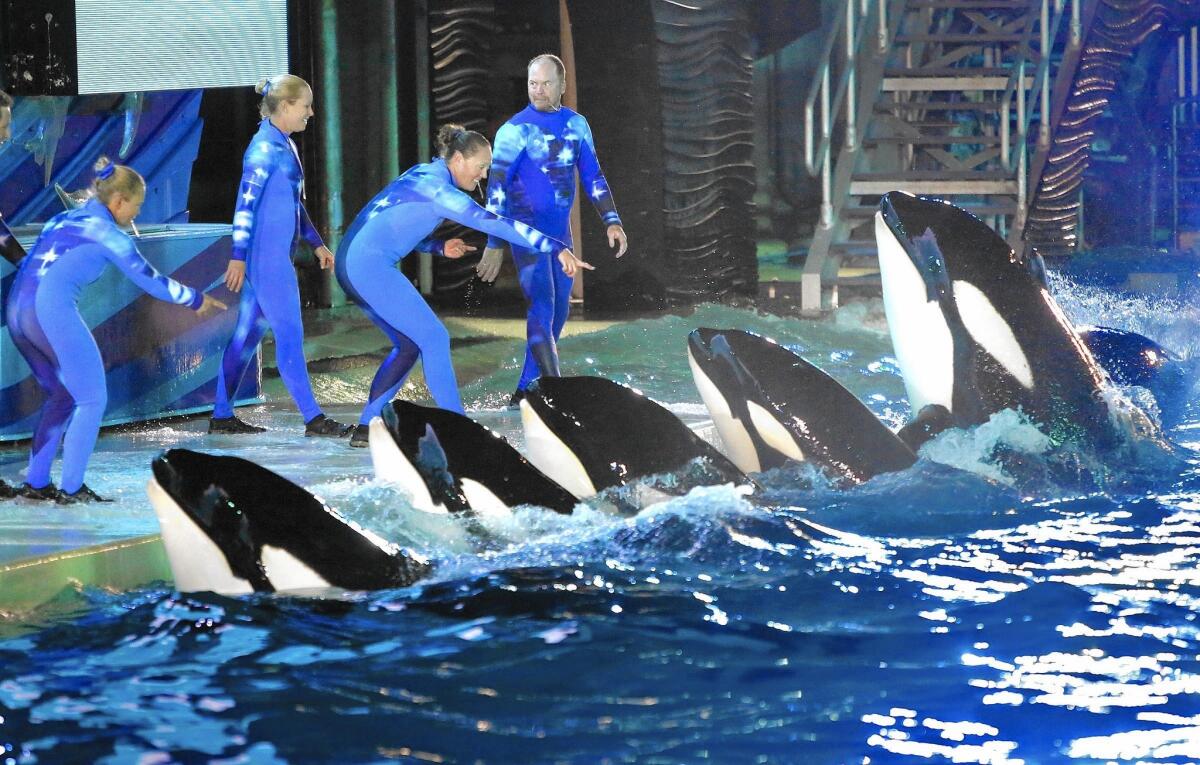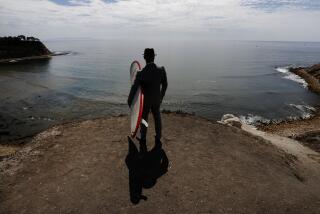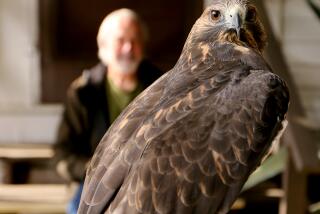SeaWorld settles orca trainer safety citations

SeaWorld and state regulators have agreed to settle safety citations issued last year alleging the San Diego marine park failed to protect its trainers when working closely with killer whales, both behind the scenes and in performances.
Among the settlement’s mandates to better protect workers: Trainers would be barred from “surfing” on the orcas and swimming under them, nor could they stand on a killer whale, except when necessary to get out of the park’s medical pool. The enclosure is one of the smaller, behind-the-scenes pools used for a number of purposes, including veterinary procedures and routine health exams.
The settlement’s proposed safety regulations are unlikely to be noticeable during SeaWorld’s theatrical Shamu shows, as the company long ago put an end to trainers cavorting in the water with the whales.
The in-water interaction during performances never resumed following the 2010 death of trainer Dawn Brancheau, who drowned in an attack by Tilikum, a 12,000-pound orca, during a show at the Orlando, Fla., marine park.
In addition to regulating interactions in the San Diego park’s medical pool, the settlement also spells out how close trainers can be to the water’s edge — 18 inches to 3 feet — when working with the killer whales on so-called slideouts that are part of the Shamu show.
Touching the whales would not be prohibited, but the proposed settlement order defines instances when it would be safe — for instance, when the trainer is positioned behind the whale’s blowhole while in the medical pool.
The settlement still needs the approval of the California Occupational Safety & Health Appeals Board. It would dismiss all four citations and related fines of nearly $26,000 against SeaWorld San Diego but requires the park to adhere to strict guidelines governing interactions between the whales and trainers.
The settlement, finalized last month, comes nearly three months after the start of a judicial hearing during which attorneys for SeaWorld and state regulators clashed over accusations that the park lacked effective plans for identifying hazards and correcting unsafe conditions.
The hearing originally had been expected to resume this month but was canceled after negotiations that began in late November and concluded last month with the filing of settlement papers Dec. 14, said Cal/OSHA spokeswoman Erika Monterroza.
In a statement released Tuesday, park spokesman Dave Koontz said SeaWorld is pleased with Cal/OSHA’s decision to withdraw its citations and impose conditions “based largely on SeaWorld’s existing safety program.” The settlement, SeaWorld said, already has been approved by an administrative law judge.
SIGN UP for the free California Inc. business newsletter >>
Koontz added: “This decision will allow SeaWorld to continue our critical animal care practices and trainer safety training methods. These techniques are important to the safety of our trainers and veterinary staff as well as the health and well-being of the orcas in our care.”
At the time of last year’s hearing before an administrative law judge, Division of Occupational Safety and Health attorney Melissa Peters raised doubts about SeaWorld’s training techniques designed to desensitize whales when it comes to close human contact.
Peters said then that evidence and testimony would show that SeaWorld procedures don’t protect employees from the potential hazards of working in close proximity to killer whales, which she likened to working around an unguarded saw blade.
SeaWorld attorney Larry Iser at the time pointed to safety features of the park’s 6-foot-deep medical pool, including a lift that can bring the floor of the pool to the surface in about 40 seconds.
Once the current settlement goes into effect, state regulators will monitor the park’s adherence to safety protocols by performing two unannounced inspections this year and next. The settlement requires SeaWorld to document all instances of “unanticipated employee contact with killer whales initiated by the whale and all near misses” that take place in the medical pool or slideouts and submerged ledges.
SeaWorld would not comment on its motivation for settling the worker safety case, although the settlement states that it entered into the agreement “in order to avoid protracted litigation and costs.”
The park’s parent company, SeaWorld Entertainment Inc., was less successful in its 4-year-long battle with the federal government over safety-related citations it received in 2010 in connection with the death of Brancheau.
In 2014, it opted not to appeal a ruling that trainers be barred from having close contact with killer whales during shows unless protected by a physical barrier.
SeaWorld’s latest legal fight comes as the marine parks continue to come under attack from animal rights activists who are critical of their treatment of killer whales and breeding them in captivity.
SeaWorld San Diego recently filed suit against the California Coastal Commission over a prohibition on captive breeding of orcas as a condition for being allowed to expand its killer whale tanks.
Company Chief Executive Joel Manby last year said the San Diego theatrical Shamu shows will be phased out after next year and replaced with an attraction that showcases the whales’ natural behavior.
MORE: Get our best stories in your Facebook feed >>
MORE BUSINESS COVERAGE
A rare stumble for biotech pioneer Alfred Mann
Five economic fears behind the Chinese stock slide that shook world markets
Samsung shows off more devices at CES as part of its smart home concept
More to Read
Inside the business of entertainment
The Wide Shot brings you news, analysis and insights on everything from streaming wars to production — and what it all means for the future.
You may occasionally receive promotional content from the Los Angeles Times.










